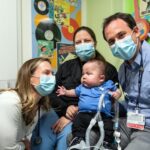Noisy breathing? It could be tracheomalacia

DJ is at his pediatrician’s office with his third bout of pneumonia this year. Katie wants to play soccer, but gasps for air when she exerts herself. Sarah’s parents have learned CPR because she has stopped breathing so many times. Although these kids appear to have very different problems, they all have one underlying cause: tracheomalacia.
Also known as tracheobronchomalacia, this problem occurs when a child’s airway narrows or collapses when they breathe. This can result in a number of symptoms, ranging from noisy breathing and a barking cough to recurrent pneumonia and even cyanosis (blue spells). Yet because some clinicians lack a detailed understanding of tracheomalacia, the condition is often misdiagnosed. If you’ve been told that your child has atypical asthma, or if they keep coming down with croup or pneumonia, tracheomalacia could be responsible.
Growing up — but not out of tracheomalacia
In a healthy trachea (or windpipe), a series of C-shaped rings of cartilage help keep your child’s airway open when they exhale. But in tracheomalacia, these rings are wide and shaped more like the letter “U” or a bow shape, which causes the membrane at the back of the airway to interfere with breathing and restrict airflow.
“Most doctors learned in medical school that kids will grow out of tracheomalacia by age 2, so you don’t need to worry about it,” says Dr. Russell Jennings, surgical director of the Esophageal and Airway Treatment Center at Boston Children’s Hospital. “But this is a misconception.”
It’s true that a child’s airway gets larger as they grow, which may help move more air and decrease the severity of symptoms over time. However, most cases of congenital tracheomalacia are due to physical malformations in the cartilage. “In these situations, tracheomalacia never completely goes away,” Dr. Jennings explains.
Understanding the problem
What should you do if you suspect your child might have tracheomalacia or a related airway condition? Dr. Jennings recommends that parents ask their clinician to perform a three-phase dynamic bronchoscopy. During this test, the doctor will use a thin instrument called a bronchoscope to look in your child’s airway in three different situations: during shallow breathing, during vigorous coughing and when the airways have been distended.
Although many doctors only perform the first phase of this test, all three phases are crucial for understanding the specifics of a child’s unique situation. The doctor may also use a dynamic airway CT scan, a noninvasive procedure that uses x-ray equipment and computers to create detailed, cross-sectional images of your child’s body. This test can’t diagnose or rule out tracheomalacia, but it can help identify other causes of tracheal compression that can cause similar symptoms.
A custom approach to care
Depending on the results — and the severity of your child’s symptom’s — the doctor may recommend approaches such as humidified air, chest physical therapy and perhaps a continuous positive airway pressure (CPAP) device and a pulmonary clearance regimen supervised by a pulmonologist.
However, your child may need surgery if tracheomalacia is more serious or if they still have problems after taking the medications. Dr. Jennings and his colleagues at the Esophageal and Airway Treatment Center offer a variety of innovative surgical procedures to treat tracheomalacia. The key is to get an accurate and detailed diagnosis first: “Every child is different,” says Dr. Jennings. “Once we understand the underlying issue, we can develop a custom treatment approach.”
Learn about the Esophageal and Airway Treatment Center and watch our recent Facebook Live event, “Tracheomalacia: More than just noisy breathing.”
Related Posts :
-

Using her voice: After tracheomalacia treatment, Claire keeps her eye on the ball
Claire Kantany is only 10, but she knows what she wants to do when she grows up — in fact, she’...
-

Optimizing care for bronchopulmonary dysplasia, infant by infant
Preterm newborns with bronchopulmonary dysplasia (BPD) can require ongoing mechanical ventilation to support their lungs. But babies with BPD aren't ...
-

Soft stents, hardened in place by UV light, allow a snug, custom fit
Airway stents are often used when the trachea and bronchi need to be buttressed, as in children and adults with ...
-

Five things parents should know about vascular rings
If your child has a high-pitched cough, breathes loudly, wheezes, has difficulty eating or swallowing, or always seems to be ...





